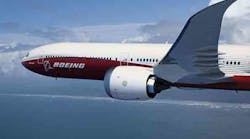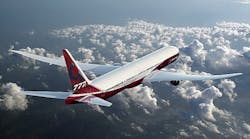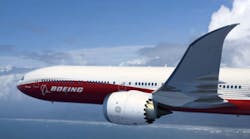Boeing Commercial Airplanes signed a memorandum of agreement with Toray Industries to expand a current supply contract for Boeing 787 composite wing structures to include wings for the 777X jet, a new wide-body, twin-engine aircraft on track for debut later this decade. Toray is a Japan-based company that is the world’s largest producer of carbon-fiber materials, as well as synthetic fiber materials.
Terms of the new contract agreement were not released, but once finalized it would take effect next year.
With this new agreement, Boeing would have contracts in place for over 75% of the 777X’s major structural material. The successor to the current 777 would start production in 2017 at Boeing's Everett, Wash., site., incorporating some technologies developed for the 787 Dreamliner, including composite wings and the GE9X high-bypass turbofan engines.
The wingspan of the 777X measures 235.4 feet (71.7 meters), 22.8 feet (6.95 meters) longer than the wingspan of the current 777-300ER. The longer reach and raked wingtips are seen enhancing fuel efficiency, and will conform with current airport gate configurations.
In June, Boeing reached a framework agreement with five Japanese manufacturers concerning a significant volume of work for the 777X jet.
In addition to the 777X and 787 program work, Boeing said it will collaborate with Toray to improve commercialization of composites in the aerospace market. Specifically, it said this collaboration would address greater consistency and performance for composites “across the production system and a cost structure that is more competitive with metals.”
"This partnership is a great example of why Toray is the market leader in composite materials," stated Boeing chief technology officer John Tracy. "Their understanding of the technology is outstanding, but they also know there is much more we can do with composites in aerospace if we work together to improve the performance, processing and economics."
The two companies collaborated more than 30 years ago to advance the use of “prepreg composites” (carbon-fiber materials strengthened with epoxy resin), and in the 1990s to assemble structural elements for the 777 program. The 777 was the first commercial aircraft program to use composite parts as structural members. Those developments were significant in the use of composites for the 787, which Boeing describes as “the world's first largely composite commercial airplane.”








